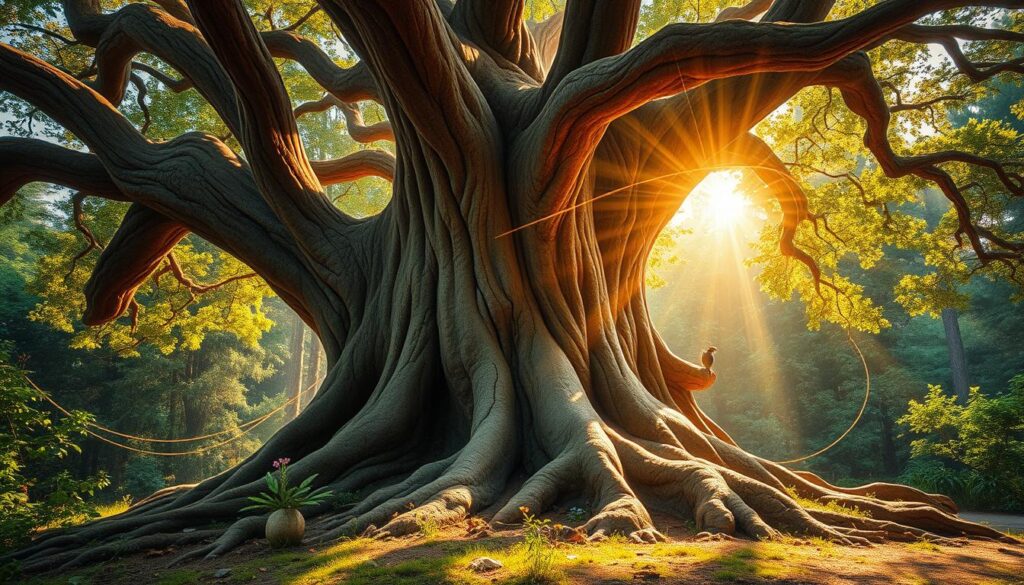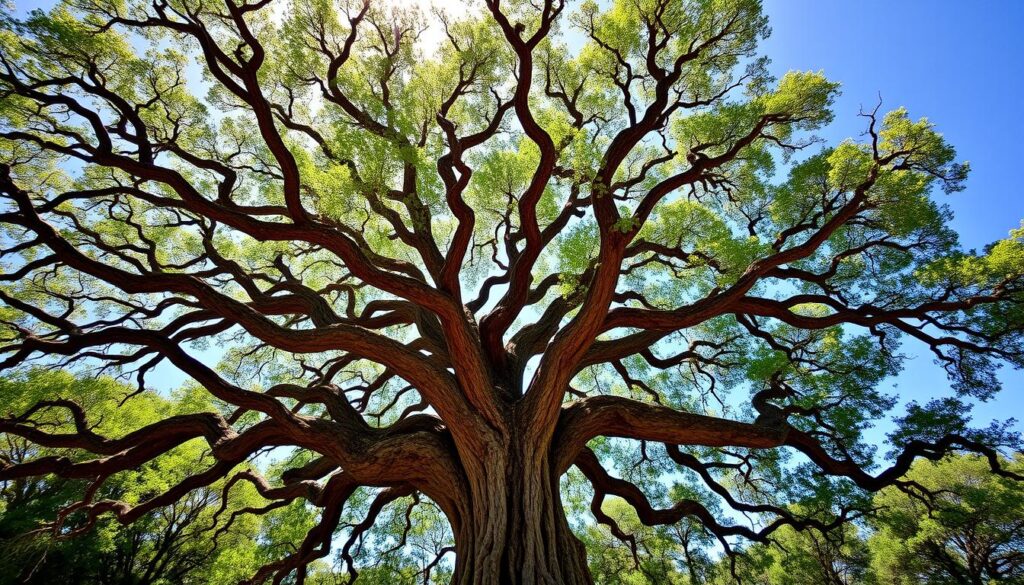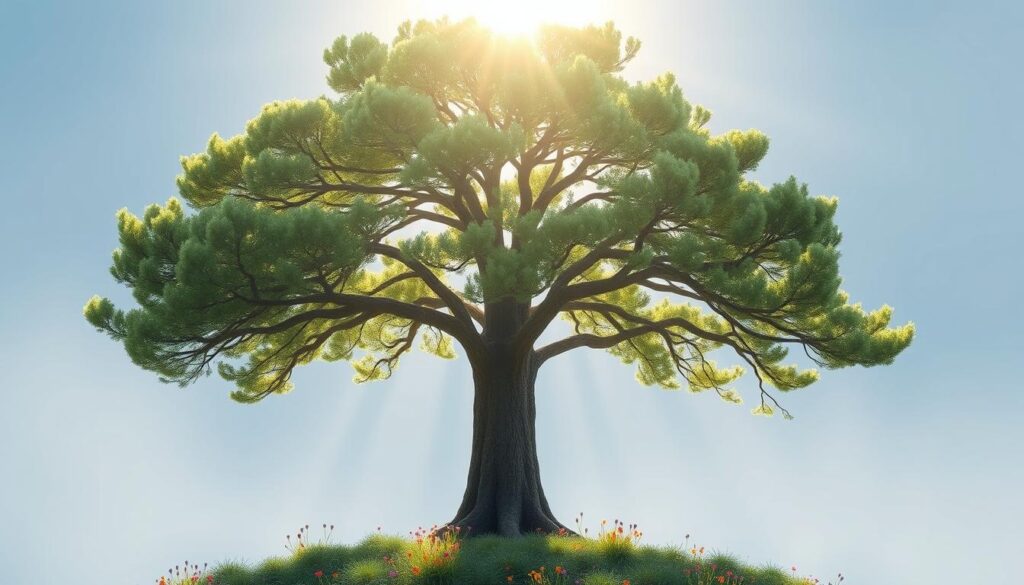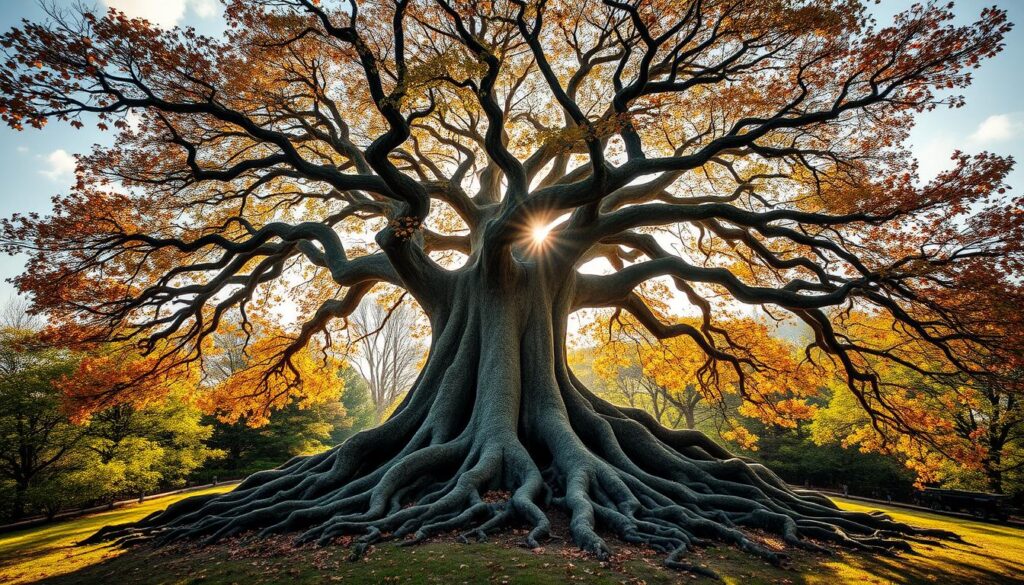Looking at the oak tree in my backyard fills me with awe. Its strong trunk and wide branches show resilience and endurance. Trees hold deep spiritual meaning across cultures and beliefs. From symbolic tree interpretations of old to today’s tree lore, trees symbolize strength, growth, and renewal.
Trees connect the physical and spiritual worlds, acting as a bridge to existence’s mysteries. Each tree, like the pine, oak, or Bodhi, has its own lessons. Exploring tree symbolism helps us connect with nature and grow personally.
Tree Symbolism: A Connection Between the Physical and Spiritual Realms

Trees are more than just plants. They connect the physical and spiritual worlds. Their movements and features send messages from nature. Trees show us the unseen forces that shape our lives.
Many cultures have seen trees as special. They believe trees link the earthly and divine realms. The Kabbalah’s Tree of Life, the Nordic Yggdrasil, and the Hindu Banyan tree are examples. They symbolize growth, connection, and spiritual growth.
Exploring tree symbolism reveals a universal language. Trees teach us about transformation and life’s rhythm. By understanding trees, we connect with nature and unlock hidden wisdom.
| Cultural Tradition | Tree Symbolism |
|---|---|
| Kabbalah | The Tree of Life consists of 10 interconnected spheres known as Sephiroth and 22 paths, serving as a blueprint for spiritual enlightenment. |
| Norse Mythology | The Nordic Tree of Life, Yggdrasil, binds together 9 realms of existence. |
| Hinduism | The Banyan tree represents divine wisdom, oneness, and cycles of birth, death, and rebirth. |
| Buddhism | The Bodhi Tree is revered as a symbol of enlightenment and tranquility, embodying the virtues of wisdom. |
| Christianity | The Tree of Life is associated with divine knowledge and eternal life, signifying hope and transcendence. |
Tree symbolism is universal, showing a deep connection between the physical and spiritual. By learning from these symbols, we appreciate nature more. This leads to a deeper understanding of our place in the world.
The Oak Tree: An Embodiment of Strength and Wisdom

The oak tree is a symbol of strength and wisdom. Its sturdy trunk and long life show endurance and resilience. It’s seen as a symbol of longevity, fertility, and protection across cultures.
Its deep roots and tall stature remind us to stay grounded in our values. This is important when facing life’s challenges.
Oak trees can live for hundreds or thousands of years. They stand strong through storms and droughts. This slow growth shows wisdom and knowledge gained over time.
In spiritual terms, the oak tree is a symbol of healing and nourishment. It offers stability and security, showing steadfastness and dependability.
There are about 500 types of oak trees, reaching heights of 20 to 40 meters. Oak leaves contain tannic acid, protecting the tree from fungi and insects. This has led to associations with thunder gods like Jupiter or Perun.
The oak tree is the national tree of many countries, including the United States, France, Germany, and Poland. This highlights its lasting symbolic power.
The oak tree’s strength and wisdom are highly respected. It symbolizes courage and bravery in the spiritual world. Its presence shows the human spirit’s ability to overcome and grow stronger through life’s challenges.
The Cedar: A Symbol of Purification and Protection

The cedar tree is highly respected in many spiritual traditions. It is known for its purification and protection qualities. This tree, with its unique scent and tough nature, symbolizes strength and resilience.
In many cultures, the cedar is used in rituals to clean spaces and keep away bad energy. Its smell, from the oils in its wood and leaves, is thought to purify and protect. The cedar’s ability to grow in tough places shows its spiritual strength, making it a symbol of inner purity.
The cedar tree symbolism, cedar tree meaning, and cedar tree spiritual significance go beyond its physical traits. Around the world, the cedar is valued for its role in purification and protection. It helps in spiritual growth and keeps away evil.
| Cedar Tree Traditions | Significance |
|---|---|
| Indigenous Rituals | Cedar smoke used to prevent illness and purify spaces |
| Judeo-Christian Stories | Cedar symbolizes protection and strength, used to build Solomon’s temple |
| Irish Folklore | Cedar associated with strength and durability due to rot-resistant wood |
| Magical Aromatherapy | Cedar essential oil used as a deterrent for moths and biting insects |
The cedar tree symbolism is deep and wide, from ancient traditions to today. It shows the cedar’s deep spiritual meaning. This tree inspires and guides those looking to grow strong and resilient in life’s tough times.
The Bodhi Tree: A Path to Enlightenment

The Bodhi tree is very important in Buddhism. It is the tree where the Buddha found enlightenment. This sacred fig tree shows the way to higher consciousness and finding one’s true self.
Its ability to grow in different places and its link to the Buddha’s awakening make it a symbol of change. It guides people on the path to enlightenment.
The Bodhi Tree is in Bodh Gaya, India. It’s about 115 km from Patna. The temple near it is from the 5th or 6th century. It’s one of the oldest Buddhist temples in India.
The Bodhi Tree is part of a big temple complex. It’s a UNESCO World Heritage Site. It’s one of the four holy sites related to the Buddha’s life.
Every year on December 8, Buddhists celebrate Bodhi Day. It’s to honor Buddha’s enlightenment under the Bodhi Tree. Branches of the original tree were taken to places like Sri Lanka and Australia.
The Bodhi Tree’s Bodhi tree symbolism goes beyond Buddhism. It’s similar to the Tree of Life in many cultures. From the Kabbalah to Celtic traditions, it shows our desire for connection and enlightenment.
The Pine Tree: A Symbol of Longevity and Immortality
The pine tree is known for its evergreen leaves and long life. It symbolizes pine tree symbolism and immortality. In many cultures, it stands for wisdom, resilience, and the strong human spirit.
Its ability to grow in tough places and live for ages makes it a symbol of timeless wisdom. The pine tree shows the strength and endurance found in nature.
The pine tree meaning is deeply spiritual. Pine trees thrive in cold, poor soil in the Northern Hemisphere. The Eastern White Pine, for example, has long needles and big cones.
These cones are used for medicine and crafts by native peoples. They also make paper and wood for building.
Burning pine needles or using pine oil is believed to heal and clear negative energy. Pine wood is also used in construction and paper making.
Pine trees offer nuts for both animals and people. These nuts are a tasty, protein-rich food.
In Asian cultures, the pine tree means longevity and immortality. It also stands for enduring strength, good fortune, and rebirth. The “Miracle Pine” in Japan survived a 2011 tsunami, showing its strength and hope.
In the U.S., pine trees are seen as symbols of eternal life. They are often planted in cemeteries. The pine tree also represents independence and resistance, as seen in the Pine Tree Riot of 1772.
The pine tree is a symbol of strength, wisdom, and spiritual importance. Its connection to longevity and immortality inspires people worldwide.
Tree Symbolism in Art and Decorative Motifs

Trees have inspired artists and artisans for centuries. From ancient Celtic carvings to Asian art, trees tell stories of spiritual depth. They show how trees carry symbolic meanings, reflecting cultural beliefs and our bond with nature.
In Art Nouveau, trees are depicted with flowing lines, symbolizing femininity and growth. Artists like Alphonse Mucha used them to show renewal or decay. This highlights nature’s beauty and our changing relationship with it.
Evergreen trees symbolize resilience and renewal. Their greenery reminds us of life’s cycles. During holidays, they symbolize hope and joy, even in winter. They also support wildlife, adding to their symbolic value.
Trees in art and motifs symbolize strength and perseverance. They show our deep connection with nature. This connection is timeless and universal, reflecting the enduring power of tree symbolism.
| Tree Symbolism in Art Nouveau | Evergreen Tree Symbolism |
|---|---|
|
|
The Yew Tree: A Duality of Life and Death
The yew tree is a fascinating symbol, showing both life and death. Its toxic nature reminds us of our mortality. Yet, it also has healing properties, used for centuries. This mix shows the tree’s role as a bridge between the physical and spiritual worlds.
In ancient times, the yew tree was linked to the underworld and death. It was planted in cemeteries and churchyards, reminding us of life’s shortness. But, its evergreen leaves and ability to grow again symbolize life’s ongoing cycle.
The yew’s healing properties add to its spiritual importance. Its bark and needles contain taxol, used to fight cancer. This mix of life and death, destruction and renewal, makes the yew tree a powerful symbol.
Whether you’re drawn to the yew’s darker side or its life-giving qualities, it teaches us about balance. It shows the connection between the physical and spiritual, and the cycle of life. By understanding this, we can see the world and our place in it more clearly.
Tree Symbolism in Various Mythologies
Trees have a special place in many cultures’ myths. The Bodhi tree is linked to the Buddha’s enlightenment in Buddhism. In Celtic beliefs, the sacred oak is revered. These trees carry deep spiritual meanings.
Looking at mythological tree representations helps us understand their role. They are seen as sources of wisdom and guardians. They connect the physical and spiritual worlds.
The Bodhi Tree of Bodh Gaya is sacred to Buddhists, Hindus, and Jains. It’s believed to be where Gautama Buddha found enlightenment. Trees are sacred in many myths, linked to the sacred tree and grove.
People worldwide hang objects on trees for connection. Trees are pilgrimage sites for prayers, healing, and blessings. They bring good luck.
The world tree concept, like Yggdrasil in Norse mythology, links heaven, earth, and the underworld. It holds the cosmos together. Tree symbolism is also seen in literature and pop culture.
In J.R.R. Tolkien’s Two Trees of Valinor and The Lord of the Rings’ White Tree of Gondor, trees play key roles. George R. R. Martin’s A Song of Ice and Fire series also features a heart tree.
Tree symbolism across cultures shows life and death, growth and decay. It connects the natural and supernatural. These cultural tree myths show trees’ lasting importance in our imagination. They bridge the physical and spiritual worlds.
The Tree of Life: A Universal Symbol of Interconnectedness

The tree of life symbolism is a powerful symbol across cultures. It shows the deep interconnectedness of all things. It reminds us of the unity between the physical and spiritual worlds. It also shows the cycle of life, death, and rebirth.
This symbol encourages us to see our role in the world. It teaches us about the connection between all living beings.
The tree of life spiritual significance has been fascinating humans for thousands of years. In Norse mythology, Yggdrasil connects the heavens, earth, and underworld. It shows the connection of the cosmos.
In Kabbalah, the Tree of Life is key. It has ten nodes, each representing a part of the divine and the universe.
The tree of life symbolism is seen in art and culture too. From sculptures in Mozambique to Gustav Klimt’s paintings, it inspires us. It helps us understand our place in the world.
| Significance of the Tree of Life | Examples Across Cultures |
|---|---|
| Interconnectedness of all life | – Yggdrasil in Norse mythology – Kabbalistic Tree of Life – Tree of Life in the Bible |
| Cycle of life, death, and rebirth | – Bodhi tree in Buddhism – Acacia tree in ancient Egypt – Tree of Life in various mythologies |
| Spiritual growth and enlightenment | – Bodhi tree and Buddha’s enlightenment – Tree of Life in Kabbalah and Hinduism – Tree of Life in Christian symbolism |
The Tree of Life shows us our deep connection to nature and the universe. It invites us to respect our place in the world. By understanding this, we can appreciate the balance of life more.
Tree Symbolism in Spiritual Growth and Personal Renewal
Trees hold deep symbolic meanings that go beyond their physical presence. They offer insights into spiritual growth and personal renewal. The aspen’s symbol of regeneration and rebirth and the oak’s strength and wisdom are just a few examples. These natural wonders are powerful metaphors for our journey through life.
Understanding tree symbolism can inspire and guide us. It helps us connect with life’s cycles, leading to personal transformation and a deeper appreciation for the world around us.
The aspen’s leaves, which tremble in the wind, symbolize spiritual awareness and sensitivity. In 80% of metaphysical studies, they are linked to heightened consciousness. The oak tree, known for its strength and wisdom, is revered in 85% of Native American traditions. It represents inner strength and the ability to endure life’s challenges.
As we grow personally, trees offer a symbolic language for renewal and self-discovery. Dreams featuring aspen trees are seen as a sign of a desire for growth and transformation by 82% of dream analysts. They are also linked to rejuvenation and rebirth by 62% of people. Embracing tree lessons can help us develop resilience, adaptability, and a deep connection to nature. This empowers us to face life’s challenges with grace and inner strength.
